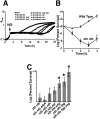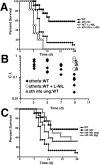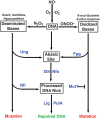The Base Excision Repair system of Salmonella enterica serovar typhimurium counteracts DNA damage by host nitric oxide
- PMID: 19478870
- PMCID: PMC2680585
- DOI: 10.1371/journal.ppat.1000451
The Base Excision Repair system of Salmonella enterica serovar typhimurium counteracts DNA damage by host nitric oxide
Abstract
Intracellular pathogens must withstand nitric oxide (NO.) generated by host phagocytes. Salmonella enterica serovar Typhimurium interferes with intracellular trafficking of inducible nitric oxide synthase (iNOS) and possesses multiple systems to detoxify NO.. Consequently, the level of NO. stress encountered by S. Typhimurium during infection in vivo has been unknown. The Base Excision Repair (BER) system recognizes and repairs damaged DNA bases including cytosine and guanine residues modified by reactive nitrogen species. Apurinic/apyrimidinic (AP) sites generated by BER glycosylases require subsequent processing by AP endonucleases. S. Typhimurium xth nfo mutants lacking AP endonuclease activity exhibit increased NO. sensitivity resulting from chromosomal fragmentation at unprocessed AP sites. BER mutant strains were thus used to probe the nature and extent of nitrosative damage sustained by intracellular bacteria during infection. Here we show that an xth nfo S. Typhimurium mutant is attenuated for virulence in C3H/HeN mice, and virulence can be completely restored by the iNOS inhibitor L-NIL. Inactivation of the ung or fpg glycosylase genes partially restores virulence to xth nfo mutant S. Typhimurium, demonstrating that NO. fluxes in vivo are sufficient to modify cytosine and guanine bases, respectively. Mutants lacking ung or fpg exhibit NO.-dependent hypermutability during infection, underscoring the importance of BER in protecting Salmonella from the genotoxic effects of host NO.. These observations demonstrate that host-derived NO. damages Salmonella DNA in vivo, and the BER system is required to maintain bacterial genomic integrity.
Conflict of interest statement
The authors have declared that no competing interests exist.
Figures




Similar articles
-
The role of DNA base excision repair in the pathogenesis of Salmonella enterica serovar Typhimurium.Mol Microbiol. 2003 Apr;48(2):549-59. doi: 10.1046/j.1365-2958.2003.03460.x. Mol Microbiol. 2003. PMID: 12675811
-
Role of Base Excision Repair in Listeria monocytogenes DNA Stress Survival During Infections.J Infect Dis. 2021 Feb 24;223(4):721-732. doi: 10.1093/infdis/jiaa412. J Infect Dis. 2021. PMID: 32644146
-
Codependent and independent effects of nitric oxide-mediated suppression of PhoPQ and Salmonella pathogenicity island 2 on intracellular Salmonella enterica serovar typhimurium survival.Infect Immun. 2009 Nov;77(11):5107-15. doi: 10.1128/IAI.00759-09. Epub 2009 Sep 8. Infect Immun. 2009. PMID: 19737903 Free PMC article.
-
Repair of oxidative DNA damage: mechanisms and functions.Cell Biochem Biophys. 2001;35(2):141-70. doi: 10.1385/CBB:35:2:141. Cell Biochem Biophys. 2001. PMID: 11892789 Review.
-
Regulation of DNA repair by S-nitrosylation.Biochim Biophys Acta. 2012 Jun;1820(6):730-5. doi: 10.1016/j.bbagen.2011.04.014. Epub 2011 May 5. Biochim Biophys Acta. 2012. PMID: 21571039 Free PMC article. Review.
Cited by
-
Low-molecular-weight thiol-dependent antioxidant and antinitrosative defences in Salmonella pathogenesis.Mol Microbiol. 2013 Feb;87(3):609-22. doi: 10.1111/mmi.12119. Epub 2012 Dec 21. Mol Microbiol. 2013. PMID: 23217033 Free PMC article.
-
The Bacterial Mfd Protein Prevents DNA Damage Induced by the Host Nitrogen Immune Response in a NER-Independent but RecBC-Dependent Pathway.PLoS One. 2016 Oct 6;11(10):e0163321. doi: 10.1371/journal.pone.0163321. eCollection 2016. PLoS One. 2016. PMID: 27711223 Free PMC article.
-
Influence of Immune Parameters after Enterococcus faecium AL41 Administration and Salmonella Infection in Chickens.Life (Basel). 2022 Jan 28;12(2):201. doi: 10.3390/life12020201. Life (Basel). 2022. PMID: 35207488 Free PMC article.
-
Identification of a chemical that inhibits the mycobacterial UvrABC complex in nucleotide excision repair.Biochemistry. 2011 Mar 1;50(8):1329-35. doi: 10.1021/bi101674c. Epub 2011 Jan 31. Biochemistry. 2011. PMID: 21235228 Free PMC article.
-
Multi-functionalized nanocarriers targeting bacterial reservoirs to overcome challenges of multi drug-resistance.Daru. 2020 Jun;28(1):319-332. doi: 10.1007/s40199-020-00337-w. Epub 2020 Mar 19. Daru. 2020. PMID: 32193748 Free PMC article. Review.
References
-
- DeGroote MA, Fang FC. Antimicrobial Properties of Nitric Oxide. In: Fang FC, editor. Nitric Oxide and Infection. New York: Kluwer Academic/Plenum Publishers; 1999. pp. 231–247.
-
- Fang FC. Antimicrobial reactive oxygen and nitrogen species: concepts and controversies. Nat Rev Microbiol. 2004;2:820–832. - PubMed
-
- Espey MG, Miranda KM, Pluta RM, Wink DA. Nitrosative capacity of macrophages is dependent on nitric-oxide synthase induction signals. J Biol Chem. 2000;275:11341–11347. - PubMed
-
- Butler AR, Megson IL. Non-heme iron nitrosyls in biology. Chem Rev. 2002;102:1155–1166. - PubMed
-
- Cooper CE. Nitric oxide and iron proteins. Biochim Biophys Acta. 1999;1411:290–309. - PubMed
Publication types
MeSH terms
Substances
Grants and funding
LinkOut - more resources
Full Text Sources

